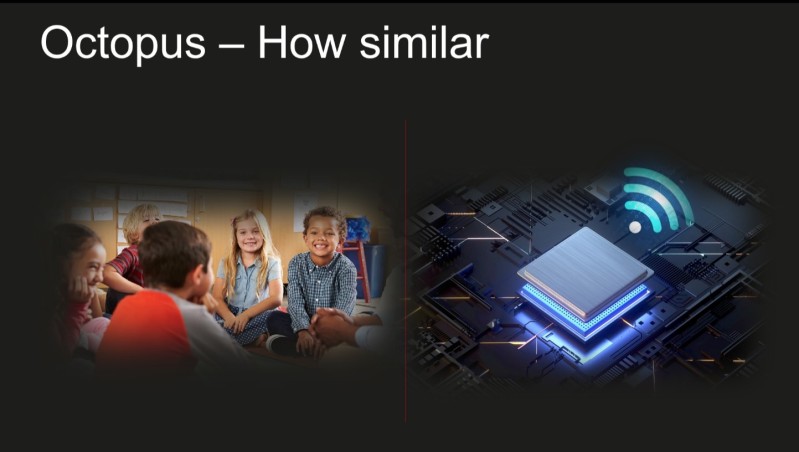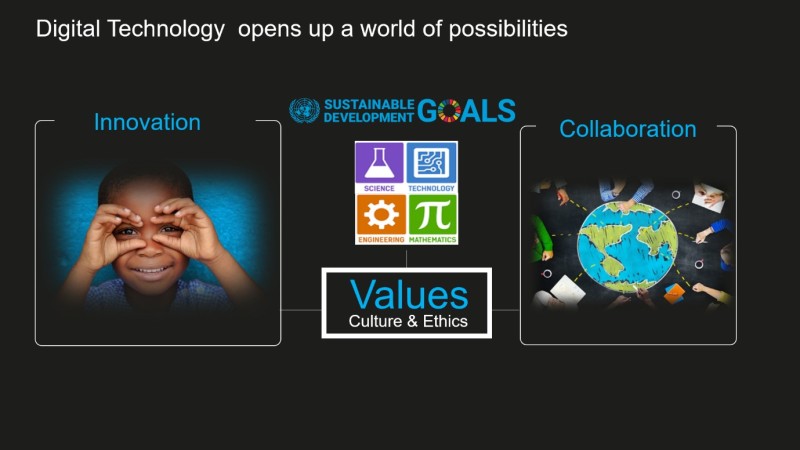Let’s start with an analogy. Contrary to the usual animals thought to be smart, many may be surprised to find the octopus in the top ten list.
Octopuses have a complex nervous system comprising nine brains. One central brain and eight mini-brains in each of its tentacles allow the animal to act independently. More surprisingly, the octopus is capable of learning and demonstrating short and long-term memory systems that work in parallel. Researchers are continuously discovering impressive abilities in cephalopods, including problem-solving, seeing light, tasting with their tentacles, and the trainability to distinguish between different shapes and patterns.
However, their smarts are not as well-known as other well-known animals, like chimpanzees and elephants.

But What do Octopuses Have to Do with ICT and AI?
I usually talk about the smart octopus as an analogy for conceptually explaining the importance of communication in the “smartness” attribute of ICT and AI. In spite of their advanced nervous systems, brains, and memory that are much like advanced computing systems, they have limited capabilities to advance their learning and intelligence.
The difference between octopuses and other notably intelligent animals, like the chimpanzee, is that the latter are far more social, with communication a key part of their intelligence. In the human world, we have realized the key role of intelligent communication to enable engagement, inclusion, and evolution towards a better life, with better education leading to productive communities.
Education Inclusion?
In today’s tech-savvy generation, it is impossible to ignore the differences between communities where most of the young population are growing up in a technologically connected environment versus those who are living without. According to UNESCO, at least 773 million young people and adults are illiterate, and 250 million children lack basic literacy skills. This results in an exclusion of low-literate and low-skilled young people and adults from fully participating in the improvement of their communities and societies.
Education inclusion is the key to enabling access to useful and affordable educational services. It gives all access to quality formal and informal learning opportunities, while reaching excluded and marginalized groups and providing them with a high-quality education.
EdTech: Advanced Technologies Enable Education for All
EdTech, the combination of “education” and “technology”, refers to technological solutions designed to enhance learning experiences and to improve students’ education outcomes.
EdTech and advanced ICT, such as high-speed Internet, cloud computing, advanced wireless infrastructure, and advanced technologies such as AI-based applications, leverage technology to increase the reach and impact of education and its workforce to accelerate learning and digital literacy, hence advancing education inclusion.

If we look at the positive impact EdTech has had on the education sector, it has offered much to increase involvement, engagement, and learning outcomes by offering e-platforms and online interactive learning materials that enrich the education process and reachability. Technology also helps to cut teacher workloads and enable a flexible approach to schools and classes, including lessons, grades, attendance, behavior, and performance. It enables expert knowledge-sharing, educational resources, tools, and data to improve engagement and communication through easy-to-use applications that improve accessibility and inclusion through distant-learning capabilities.
Connectivity has become the backbone of facilitating collaboration and engagement through connecting teachers to students, teachers to parents, and students to students with the use of smart phones, tablets, computers, smart devices, platforms, and applications.
AI Opens Up a World of Possibilities
If we look one more step at key technology such as AI, to assess its benefits in EdTech, we see that AI is changing the education sector in many sectors.
One significant use of AI is providing special education alternatives for children with diverse learning needs. AI-powered teaching assistant’s tools with capabilities, such as Natural Language Processing (NLP), voice and image recognition, text to speech and speech to text, can be successfully trained to help students as required. AI has been used for the recognition and interpretation of sign language and, as exemplified by the StorySign app, to help children to learn to read. Moreover, the use of home learning apps boost literacy and communication skills, widen accessibility, and improve the delivery of training in online basic skills.
The other important use of AI is the automation of administrative tasks. It not only provides teachers with the tools necessary to effectively and quickly grade assessments, homework and assignments, but also provides students with valued feedback in a matter of minutes. AI has made it possible for teachers to tailor their study programs according to responses from students.
AI is also empowering teachers, saving hours of collecting data and evaluating the strengths and weaknesses of students.
ICT in the Educational Digital Transformation Path
The United Nations 17 SDGs Sustainable development Goals (SDGs) represent a blueprint for a better and more sustainable future for all. There is a strong correlation between the UN SDGs and the advancement of ICT development in nation’s infrastructure, where ICT accelerates the achievement of those SDG.
SDG4 aims to ensure inclusive and quality education for all and promote lifelong learning, and is one of the SDGs that has the highest correlation with ICT (more than 70%). This high correlation value indicates that a country’s overall advancement in the education level is closely related to ICT advancement.
Key technologies such as high-speed and high-quality broadband connectivity, digital platforms, cloudification, AI-based infrastructure and applications are all necessary foundation to enable digitalization and developing the digital skills that benefit the path of the whole society, not just students

Those advanced technologies are continuously expanding into every aspect of the digital transformation of education, making a positive contribution that continues. However, still more work and global collaboration are needed to reduce educational digital gaps. For example, encouraging programs such as STEM (science, technology, engineering, and mathematics) definitely helps to bridge ethnic and gender gaps, while playing a critical role in the sustained growth and stability of economy.
Developing strategies for advanced EdTech digital technologies, AI-based solutions, platforms, connectivity, and tools to foster creativity and divergent thinking can enable knowledge sharing, improve teacher-led activities to motivate, and inspire the young population to generate new solutions and ideas.
Last and not least, strong need for creating working collaboration model among all educational stake-holders and technology to enable engagement, cultivating innovation culture that put values and ethics at the core.
Learn more about Huawei’s education projects under our digital inclusion initiative TECH4ALL.
Article Source: HuaWei
Article Source: HuaWei
Disclaimer: Any views and/or opinions expressed in this post by individual authors or contributors are their personal views and/or opinions and do not necessarily reflect the views and/or opinions of Huawei Technologies.



